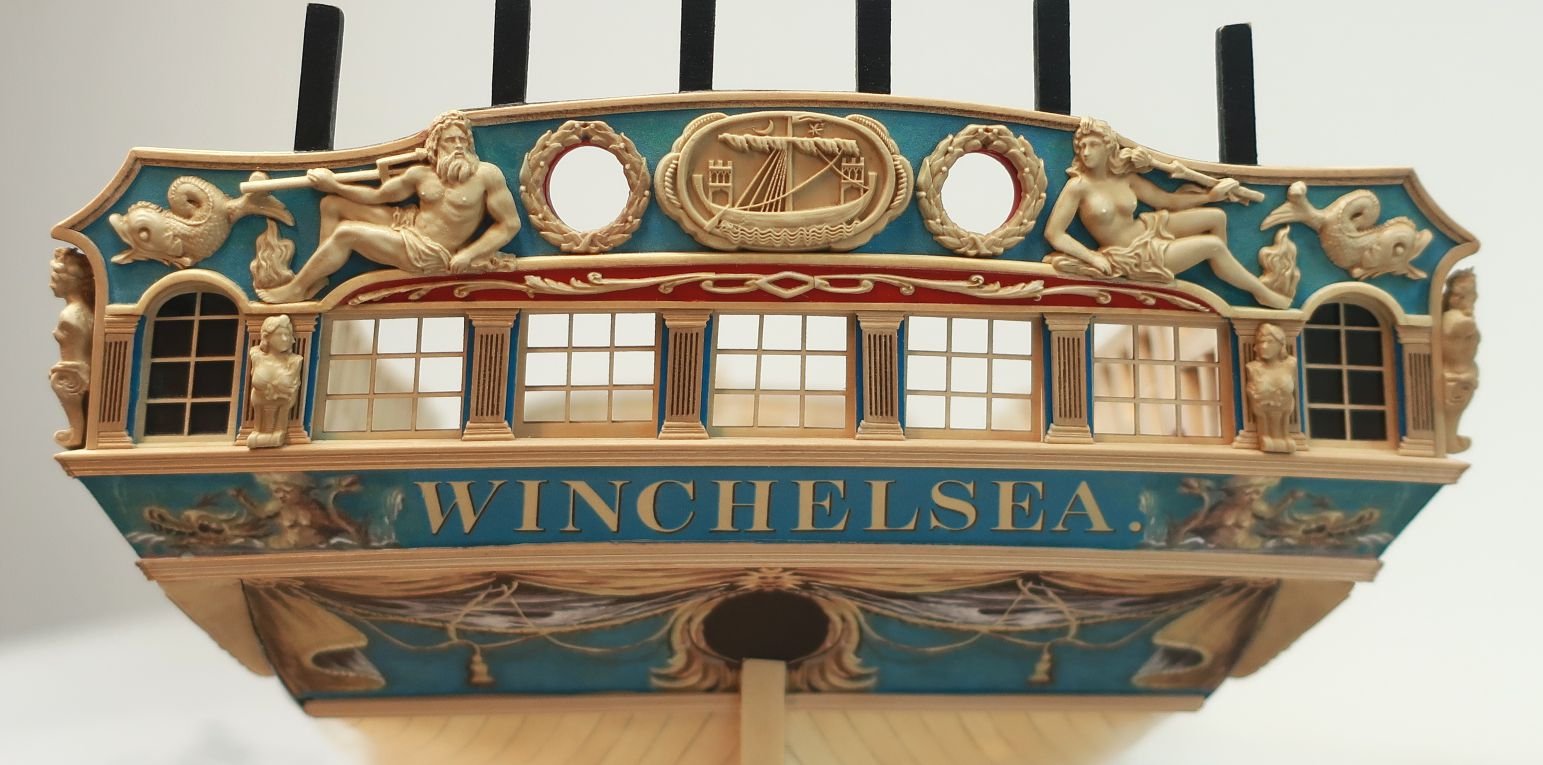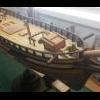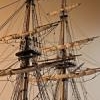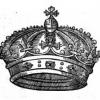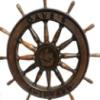-
Posts
9,093 -
Joined
-
Last visited
Reputation Activity
-
 Chuck got a reaction from mtbediz in HM Cutter Cheerful 1806 by Chuck - FINISHED - 1:48 scale - kit prototype
Chuck got a reaction from mtbediz in HM Cutter Cheerful 1806 by Chuck - FINISHED - 1:48 scale - kit prototype
And just to round out the images of where I spend 10 - 12 hours per day...
This is the other side of the shop which is in my basement...yes I know it is an absolute bloody mess. In total its about 25 feet long and 18 feet wide with that little hallway which leads to my kids man cave.
This is my block making station where yesterday I finished up milling 2000 2mm blocks. Theres a lot of sawdust on the floor....and my shop mascot snuck in the picture. You can see a drill press behind my hi-tech dust control system...the fan. , Byrnes saw and Sherline mill.
This is one half of my rope making station...You can see one half of that cheapo ME ropewalk on the table as well as all of the scraps from making a few thousand feet of rope over the last few days....I WANT TO BELIEVE.
I will be bringing all of that rope making stuff to St Louis to do a demo for the NRg Conference. I will be showuing how I make 20 - 23 foot lengths of rope on that little Model Shipways rope walk....thats how I make all of it.
And then looking down the length of my basement and down the 30 foot long hallway to the other end of the rope making station. This is where I make my rope. Nothing too terribly exciting. Alond the wall is my library and a bunch of old models...including the 18th century model that I should really find a better place for. There is another old Dutch model there too that is crying out for some love and restoration. I have no idea what it is but looks about 60 - 70 years old. Maybe. By God I have to tidy up this place...there is crap all over. I am embarrassed.
-
 Chuck got a reaction from flying_dutchman2 in Dictionary of British Naval Battles By John D. Grainger
Chuck got a reaction from flying_dutchman2 in Dictionary of British Naval Battles By John D. Grainger
Dictionary of British Naval Battles
By John D. Grainger
Woodbridge, Suffolk: The Boydell Press, 2012
6-1/2” x 9-1/2”, hardcover, xiv + 588 pages
Maps, glossary, bibliography, index. $90.00
ISBN: 9781843837046
John D. Grainger has presented readers with a thorough and accessible reference source on British naval encounters in his book, Dictionary of British Naval Battles. Focusing on British naval encounters from the Middle Ages through modern day, Grainger offers a new resource for naval historians and those with a casual interest in naval warfare alike. Addressing not only on the major battles of British naval history but on small naval encounters as well, Grainger offers an interpretation of Britain’s naval prowess rarely covered in other accounts. In doing so, Grainger presents the development of a diverse and influential naval force that became the dominant power on the sea throughout much of history.
Grainger’s central objective is to demonstrate the breadth and multiplicity of British naval power throughout British history. Highlighting the widespread influence of Britain across the globe and its use of naval power to obtain this supremacy, Grainger aptly portrays the British navy as an active and disseminated entity almost continuously utilized. Using largely secondary sources, Grainger discusses each naval encounter in a clear and concise manor, detailing the vessels involved and their outfits, in addition to discussing the details of each event.
Grainger organizes his work by naval vessel and individual battle, allowing him to discuss even small naval encounters largely overlooked in many British naval histories. Grainger begins his work discussing the meaning of the expressions “British”, “naval” and “dictionary”, effectively describing his definitions for the words as they pertain to the topics included in his work. Maintaining that “British” must include any navy under British rule, in one volume, Grainger effectively is able to discuss naval encounters ranging from the northern Irish attack on the Hebrides in 580 AD to Britain’s naval endeavors in the Persian Gulf. Focusing on each naval battle in turn, Grainger maintains a level of detail in each entry that surpasses many other works of the same nature.
Grainger has produced detailed and well-crafted entries on a wide range of British naval topics, spanning from the medieval period to modern day. While his research is comprehensive, his scope remains very large, which at times can seem overwhelming. Though his general outline takes a logical and systematic approach, the wide range of topics covered has the potential to lose a reader. At times, the chronology of events is lost due to the alphabetical organization of the work, taking away from a more liminal understanding of Britain’s naval history.
Despite this, Grainger clearly addresses his organizational technique in his introduction, and provides readers with additional references at the end of each entry for those interested in learning more about specific topics. Overall, Grainger has produced a well-researched and skillfully written addition to the canon of British naval history. Grainger has developed a valuable source of knowledge on British naval events, effectively producing an important reference source on British vessels, battles, and naval warfare.
Caitlin Zant
East Carolina University
-
 Chuck reacted to Jim Lad in America’s Black Sea Fleet By Robert Shenk
Chuck reacted to Jim Lad in America’s Black Sea Fleet By Robert Shenk
America’s Black Sea Fleet: The U.S. Navy Amidst War and Revolution, 1919-1921
By Robert Shenk
Annapolis: Naval Institute Press, 2012
6-1/4” x 9-1/4”, hardcover, xviii + 366 pages
Photographs, maps, notes, bibliography, index. $34.95
ISBN: 9781612510538
America’s Black Sea Fleet: The U.S. Navy Amidst War and Revolution, 1919- 1923, by Robert Shenk, offers a rare glimpse of the American naval presence in post- World War I Europe and Western Asia. His holistic representation of the events surrounding the fleet’s activities, from relief work to back-door diplomacy, allows readers to immerse themselves fully in this often-overlooked segment of world history. In particular, Shenk succeeds in his goal of presenting an overarching, non-biased view of American-Turkish relations during this time, particularly concerning the Armenian genocides. In such a heated debate, it is a breath of fresh air to see Admiral Bristol represented, not as a singular ideal, but as a man, capable of good deeds even with his shortcomings.
Shenk has certainly proven himself as an historical researcher. In writing this book, he utilized a variety of public and private source material in his attempt to present a well-rounded interpretation, including diaries, ship logs, correspondence, archival collections, photographs, and more. This enterprising appetite for published and unpublished source material is impressive. In particular, his extensive use of the Mark L. Bristol papers for the good of the overall scholarly argument, rather than as propaganda for a one-sided attack, is certainly commendable. His endnotes allow ease for both the casual reader and the serious historian, as the background information and sources are present, but do not interfere with the general flow of the work.
Shenk’s organizational scheme, on the other hand, leaves something to be desired. Though most social histories are thematic, this one tends to jump across years, continents, and ships, with little to no respect for the reader. Additionally, Shenk discusses individual naval movements without giving them an appropriate context in the history of the area, though he states this as one of his goals in the preface. This is true for the end of World War I as well as the immediate after-effects in Greece, Turkey, the Balkans, and particularly post-revolutionary Russia. A more detailed account of the situation, as well as maps to orient the reader, would have been extremely helpful. Both casual readers and naval historians alike might suffer from the lack of historical context. Additionally, the writing was awkward and disjointed in many places. Decisions in word choice, phrasing, and punctuation, should have worked for the storyline, rather than against it. The overuse of parenthetic remarks was particularly frustrating. If the purpose of the endnotes was to allow for readability, Shenk could have also avoided the prolific use of parentheses, most of which he could have worked into the text or relegated to the notes section.
This book is certainly more than a naval history. While it examines naval officers, operations, and vessels, it also gives a brief insight into the society of post-World War I Eastern Europe and Western Asia. Shenk focuses on individual ships, but also on the basic human condition during this tumultuous era. This work perhaps would have benefitted from more time in the editing process. It stands, however, as a good example of primary source research and is an excellent addition to the subject literature.
Chelsea Freeland
East Carolina University
-
 Chuck got a reaction from druxey in Dictionary of British Naval Battles By John D. Grainger
Chuck got a reaction from druxey in Dictionary of British Naval Battles By John D. Grainger
Dictionary of British Naval Battles
By John D. Grainger
Woodbridge, Suffolk: The Boydell Press, 2012
6-1/2” x 9-1/2”, hardcover, xiv + 588 pages
Maps, glossary, bibliography, index. $90.00
ISBN: 9781843837046
John D. Grainger has presented readers with a thorough and accessible reference source on British naval encounters in his book, Dictionary of British Naval Battles. Focusing on British naval encounters from the Middle Ages through modern day, Grainger offers a new resource for naval historians and those with a casual interest in naval warfare alike. Addressing not only on the major battles of British naval history but on small naval encounters as well, Grainger offers an interpretation of Britain’s naval prowess rarely covered in other accounts. In doing so, Grainger presents the development of a diverse and influential naval force that became the dominant power on the sea throughout much of history.
Grainger’s central objective is to demonstrate the breadth and multiplicity of British naval power throughout British history. Highlighting the widespread influence of Britain across the globe and its use of naval power to obtain this supremacy, Grainger aptly portrays the British navy as an active and disseminated entity almost continuously utilized. Using largely secondary sources, Grainger discusses each naval encounter in a clear and concise manor, detailing the vessels involved and their outfits, in addition to discussing the details of each event.
Grainger organizes his work by naval vessel and individual battle, allowing him to discuss even small naval encounters largely overlooked in many British naval histories. Grainger begins his work discussing the meaning of the expressions “British”, “naval” and “dictionary”, effectively describing his definitions for the words as they pertain to the topics included in his work. Maintaining that “British” must include any navy under British rule, in one volume, Grainger effectively is able to discuss naval encounters ranging from the northern Irish attack on the Hebrides in 580 AD to Britain’s naval endeavors in the Persian Gulf. Focusing on each naval battle in turn, Grainger maintains a level of detail in each entry that surpasses many other works of the same nature.
Grainger has produced detailed and well-crafted entries on a wide range of British naval topics, spanning from the medieval period to modern day. While his research is comprehensive, his scope remains very large, which at times can seem overwhelming. Though his general outline takes a logical and systematic approach, the wide range of topics covered has the potential to lose a reader. At times, the chronology of events is lost due to the alphabetical organization of the work, taking away from a more liminal understanding of Britain’s naval history.
Despite this, Grainger clearly addresses his organizational technique in his introduction, and provides readers with additional references at the end of each entry for those interested in learning more about specific topics. Overall, Grainger has produced a well-researched and skillfully written addition to the canon of British naval history. Grainger has developed a valuable source of knowledge on British naval events, effectively producing an important reference source on British vessels, battles, and naval warfare.
Caitlin Zant
East Carolina University
-
 Chuck got a reaction from scratch in Dictionary of British Naval Battles By John D. Grainger
Chuck got a reaction from scratch in Dictionary of British Naval Battles By John D. Grainger
Dictionary of British Naval Battles
By John D. Grainger
Woodbridge, Suffolk: The Boydell Press, 2012
6-1/2” x 9-1/2”, hardcover, xiv + 588 pages
Maps, glossary, bibliography, index. $90.00
ISBN: 9781843837046
John D. Grainger has presented readers with a thorough and accessible reference source on British naval encounters in his book, Dictionary of British Naval Battles. Focusing on British naval encounters from the Middle Ages through modern day, Grainger offers a new resource for naval historians and those with a casual interest in naval warfare alike. Addressing not only on the major battles of British naval history but on small naval encounters as well, Grainger offers an interpretation of Britain’s naval prowess rarely covered in other accounts. In doing so, Grainger presents the development of a diverse and influential naval force that became the dominant power on the sea throughout much of history.
Grainger’s central objective is to demonstrate the breadth and multiplicity of British naval power throughout British history. Highlighting the widespread influence of Britain across the globe and its use of naval power to obtain this supremacy, Grainger aptly portrays the British navy as an active and disseminated entity almost continuously utilized. Using largely secondary sources, Grainger discusses each naval encounter in a clear and concise manor, detailing the vessels involved and their outfits, in addition to discussing the details of each event.
Grainger organizes his work by naval vessel and individual battle, allowing him to discuss even small naval encounters largely overlooked in many British naval histories. Grainger begins his work discussing the meaning of the expressions “British”, “naval” and “dictionary”, effectively describing his definitions for the words as they pertain to the topics included in his work. Maintaining that “British” must include any navy under British rule, in one volume, Grainger effectively is able to discuss naval encounters ranging from the northern Irish attack on the Hebrides in 580 AD to Britain’s naval endeavors in the Persian Gulf. Focusing on each naval battle in turn, Grainger maintains a level of detail in each entry that surpasses many other works of the same nature.
Grainger has produced detailed and well-crafted entries on a wide range of British naval topics, spanning from the medieval period to modern day. While his research is comprehensive, his scope remains very large, which at times can seem overwhelming. Though his general outline takes a logical and systematic approach, the wide range of topics covered has the potential to lose a reader. At times, the chronology of events is lost due to the alphabetical organization of the work, taking away from a more liminal understanding of Britain’s naval history.
Despite this, Grainger clearly addresses his organizational technique in his introduction, and provides readers with additional references at the end of each entry for those interested in learning more about specific topics. Overall, Grainger has produced a well-researched and skillfully written addition to the canon of British naval history. Grainger has developed a valuable source of knowledge on British naval events, effectively producing an important reference source on British vessels, battles, and naval warfare.
Caitlin Zant
East Carolina University
-
 Chuck got a reaction from Rustyj in HM Cutter Cheerful 1806 by Chuck - FINISHED - 1:48 scale - kit prototype
Chuck got a reaction from Rustyj in HM Cutter Cheerful 1806 by Chuck - FINISHED - 1:48 scale - kit prototype
Natural is the safe way to go. I think I am a bit more adventurous than that. So I will go with the Surly color scheme. It will be interesting to see a few more with different paint schemes should any of you decide to build her as well. Thats the fun part of this hobby.
But who knows, I could change my mind tomorrow.
-
 Chuck got a reaction from KenW in HM Cutter Cheerful 1806 by Chuck - FINISHED - 1:48 scale - kit prototype
Chuck got a reaction from KenW in HM Cutter Cheerful 1806 by Chuck - FINISHED - 1:48 scale - kit prototype
Natural is the safe way to go. I think I am a bit more adventurous than that. So I will go with the Surly color scheme. It will be interesting to see a few more with different paint schemes should any of you decide to build her as well. Thats the fun part of this hobby.
But who knows, I could change my mind tomorrow.
-
 Chuck got a reaction from yvesvidal in HM Cutter Cheerful 1806 by Chuck - FINISHED - 1:48 scale - kit prototype
Chuck got a reaction from yvesvidal in HM Cutter Cheerful 1806 by Chuck - FINISHED - 1:48 scale - kit prototype
Natural is the safe way to go. I think I am a bit more adventurous than that. So I will go with the Surly color scheme. It will be interesting to see a few more with different paint schemes should any of you decide to build her as well. Thats the fun part of this hobby.
But who knows, I could change my mind tomorrow.
-
 Chuck got a reaction from gjdale in HM Cutter Cheerful 1806 by Chuck - FINISHED - 1:48 scale - kit prototype
Chuck got a reaction from gjdale in HM Cutter Cheerful 1806 by Chuck - FINISHED - 1:48 scale - kit prototype
Natural is the safe way to go. I think I am a bit more adventurous than that. So I will go with the Surly color scheme. It will be interesting to see a few more with different paint schemes should any of you decide to build her as well. Thats the fun part of this hobby.
But who knows, I could change my mind tomorrow.
-
 Chuck got a reaction from AntonyUK in HM Cutter Cheerful 1806 by Chuck - FINISHED - 1:48 scale - kit prototype
Chuck got a reaction from AntonyUK in HM Cutter Cheerful 1806 by Chuck - FINISHED - 1:48 scale - kit prototype
Natural is the safe way to go. I think I am a bit more adventurous than that. So I will go with the Surly color scheme. It will be interesting to see a few more with different paint schemes should any of you decide to build her as well. Thats the fun part of this hobby.
But who knows, I could change my mind tomorrow.
-
 Chuck got a reaction from SailorGreg in HM Cutter Cheerful 1806 by Chuck - FINISHED - 1:48 scale - kit prototype
Chuck got a reaction from SailorGreg in HM Cutter Cheerful 1806 by Chuck - FINISHED - 1:48 scale - kit prototype
Natural is the safe way to go. I think I am a bit more adventurous than that. So I will go with the Surly color scheme. It will be interesting to see a few more with different paint schemes should any of you decide to build her as well. Thats the fun part of this hobby.
But who knows, I could change my mind tomorrow.
-
 Chuck got a reaction from mtaylor in HM Cutter Cheerful 1806 by Chuck - FINISHED - 1:48 scale - kit prototype
Chuck got a reaction from mtaylor in HM Cutter Cheerful 1806 by Chuck - FINISHED - 1:48 scale - kit prototype
Natural is the safe way to go. I think I am a bit more adventurous than that. So I will go with the Surly color scheme. It will be interesting to see a few more with different paint schemes should any of you decide to build her as well. Thats the fun part of this hobby.
But who knows, I could change my mind tomorrow.
-
 Chuck got a reaction from reilly in HM Cutter Cheerful 1806 by Chuck - FINISHED - 1:48 scale - kit prototype
Chuck got a reaction from reilly in HM Cutter Cheerful 1806 by Chuck - FINISHED - 1:48 scale - kit prototype
Natural is the safe way to go. I think I am a bit more adventurous than that. So I will go with the Surly color scheme. It will be interesting to see a few more with different paint schemes should any of you decide to build her as well. Thats the fun part of this hobby.
But who knows, I could change my mind tomorrow.
-
 Chuck got a reaction from egkb in HM Cutter Cheerful 1806 by Chuck - FINISHED - 1:48 scale - kit prototype
Chuck got a reaction from egkb in HM Cutter Cheerful 1806 by Chuck - FINISHED - 1:48 scale - kit prototype
Natural is the safe way to go. I think I am a bit more adventurous than that. So I will go with the Surly color scheme. It will be interesting to see a few more with different paint schemes should any of you decide to build her as well. Thats the fun part of this hobby.
But who knows, I could change my mind tomorrow.
-
 Chuck got a reaction from druxey in HM Cutter Cheerful 1806 by Chuck - FINISHED - 1:48 scale - kit prototype
Chuck got a reaction from druxey in HM Cutter Cheerful 1806 by Chuck - FINISHED - 1:48 scale - kit prototype
Natural is the safe way to go. I think I am a bit more adventurous than that. So I will go with the Surly color scheme. It will be interesting to see a few more with different paint schemes should any of you decide to build her as well. Thats the fun part of this hobby.
But who knows, I could change my mind tomorrow.
-
 Chuck got a reaction from Jason in HM Cutter Cheerful 1806 by Chuck - FINISHED - 1:48 scale - kit prototype
Chuck got a reaction from Jason in HM Cutter Cheerful 1806 by Chuck - FINISHED - 1:48 scale - kit prototype
I am actually leaning towards the Surly paint scheme. Black caprail and black sheer strip, with red bulwarks and red counter. But that can change, This is always a struggle for me to decide.
Chuck
-
 Chuck got a reaction from SawdustDave in HM Cutter Cheerful 1806 by Chuck - FINISHED - 1:48 scale - kit prototype
Chuck got a reaction from SawdustDave in HM Cutter Cheerful 1806 by Chuck - FINISHED - 1:48 scale - kit prototype
Almost forgot.....looking for some second opinions. I am thinking about painting the lower counter and leaving the transom natural. Like the Surly contemporary model. What do you think? Maybe blue....but not this bright. Is it too much? Maybe leave it all natural back there?
You will also note how the Surly had the bulwarks cut down which is why the transom is a funky shape. This was done during a refit long after the Cheerful was already gone. Cheerful didnt last too long. Maybe I will switch and call her the Surly....I am not feeling too cheerful today..
Chuck
-
 Chuck got a reaction from aviaamator in HM Cutter Cheerful 1806 by Chuck - FINISHED - 1:48 scale - kit prototype
Chuck got a reaction from aviaamator in HM Cutter Cheerful 1806 by Chuck - FINISHED - 1:48 scale - kit prototype
Got the counter and the transom planked. You may notice that I thinned down the outside stern frames considerably before planking the stern. The first photo shows how thick they were before it was planked. After the sides of the hull were planked the outside stern frames were strong enough to handle the thinning down. It makes the model more historically correct. The inboard side of the stern and counter will not be planked so I wanted to make sure it looked as authentic as possible. That of course means that I must really clean up the inboard side between the stern frames carefully to prepare it for painting. I will fill any cracks and sand it smooth and do lots of surface prep.
Now I can have some fun. Its time to put the fashion pieces on and the wales and fancy trim. This is the step that will make it really come together.
Chuck
-
 Chuck got a reaction from Archi in HM Cutter Cheerful 1806 by Chuck - FINISHED - 1:48 scale - kit prototype
Chuck got a reaction from Archi in HM Cutter Cheerful 1806 by Chuck - FINISHED - 1:48 scale - kit prototype
Almost forgot.....looking for some second opinions. I am thinking about painting the lower counter and leaving the transom natural. Like the Surly contemporary model. What do you think? Maybe blue....but not this bright. Is it too much? Maybe leave it all natural back there?
You will also note how the Surly had the bulwarks cut down which is why the transom is a funky shape. This was done during a refit long after the Cheerful was already gone. Cheerful didnt last too long. Maybe I will switch and call her the Surly....I am not feeling too cheerful today..
Chuck
-
 Chuck got a reaction from SawdustDave in HM Cutter Cheerful 1806 by Chuck - FINISHED - 1:48 scale - kit prototype
Chuck got a reaction from SawdustDave in HM Cutter Cheerful 1806 by Chuck - FINISHED - 1:48 scale - kit prototype
Got the counter and the transom planked. You may notice that I thinned down the outside stern frames considerably before planking the stern. The first photo shows how thick they were before it was planked. After the sides of the hull were planked the outside stern frames were strong enough to handle the thinning down. It makes the model more historically correct. The inboard side of the stern and counter will not be planked so I wanted to make sure it looked as authentic as possible. That of course means that I must really clean up the inboard side between the stern frames carefully to prepare it for painting. I will fill any cracks and sand it smooth and do lots of surface prep.
Now I can have some fun. Its time to put the fashion pieces on and the wales and fancy trim. This is the step that will make it really come together.
Chuck
-
 Chuck got a reaction from Nirvana in HM Cutter Cheerful 1806 by Chuck - FINISHED - 1:48 scale - kit prototype
Chuck got a reaction from Nirvana in HM Cutter Cheerful 1806 by Chuck - FINISHED - 1:48 scale - kit prototype
The planking above the wales is basically completed. Just a few more planks to add on the port side as you can see. I didnt bother simulating the caulking between the seams where it wont show. So it looks a bit weird now. But once the molding and second layer of the wales is added it will look fine.
You can only see a few places with a crisp line for the seams. This was done by running a number two pencil down one plank edge. If I did this on both plank edges it would have been too pronounced for my tastes.
I will plank the transom and counter next at the stern. Its an interesting detail that in case of a cutter like this you dont plank the stern counter first. The transom and counter are planked after the sides of the hull. The exposed end-grain of the counter planking and transom planking will be protected from the elements and rot by the fashion pieces. You can see them in the profile drawing. So you will not see any of the end grain from the planking. The frame for the square tuck also does this for the end grain of the planks. Its an interesting feature and I almost forgot NOT to plank the counter first. It is something I am so accustomed to doing.
Before I plank the stern transom and counter I have some shaping of the outer stern frames to do. I will post pictures of this as well because its an important feature to keeping the finished model looking accurate. So far its coming together quite well without any real issues. Its a fun build so far. You can start to see the final shape of the cutter come to life as the planking progresses. I know the bulwarks look thick at this point but they will actually be thinned down quite a bit soon. The outboard and inboard planking at the sheer was actually just 1 1/2" thick....once its planked inboard and out the final width will be just 1/8 - 5/32" thick at the most. Closer to 1/8" thick I hope.
-
 Chuck reacted to tarbrush in HM Cutter Cheerful 1806 by Chuck - FINISHED - 1:48 scale - kit prototype
Chuck reacted to tarbrush in HM Cutter Cheerful 1806 by Chuck - FINISHED - 1:48 scale - kit prototype
I would vote for the the Surly paint scheme, the red looks great to me.
-
 Chuck got a reaction from tarbrush in HM Cutter Cheerful 1806 by Chuck - FINISHED - 1:48 scale - kit prototype
Chuck got a reaction from tarbrush in HM Cutter Cheerful 1806 by Chuck - FINISHED - 1:48 scale - kit prototype
I am actually leaning towards the Surly paint scheme. Black caprail and black sheer strip, with red bulwarks and red counter. But that can change, This is always a struggle for me to decide.
Chuck
-
 Chuck got a reaction from Archi in HM Cutter Cheerful 1806 by Chuck - FINISHED - 1:48 scale - kit prototype
Chuck got a reaction from Archi in HM Cutter Cheerful 1806 by Chuck - FINISHED - 1:48 scale - kit prototype
Got the counter and the transom planked. You may notice that I thinned down the outside stern frames considerably before planking the stern. The first photo shows how thick they were before it was planked. After the sides of the hull were planked the outside stern frames were strong enough to handle the thinning down. It makes the model more historically correct. The inboard side of the stern and counter will not be planked so I wanted to make sure it looked as authentic as possible. That of course means that I must really clean up the inboard side between the stern frames carefully to prepare it for painting. I will fill any cracks and sand it smooth and do lots of surface prep.
Now I can have some fun. Its time to put the fashion pieces on and the wales and fancy trim. This is the step that will make it really come together.
Chuck
-
 Chuck got a reaction from Kevin in HM Cutter Cheerful 1806 by Chuck - FINISHED - 1:48 scale - kit prototype
Chuck got a reaction from Kevin in HM Cutter Cheerful 1806 by Chuck - FINISHED - 1:48 scale - kit prototype
Almost forgot.....looking for some second opinions. I am thinking about painting the lower counter and leaving the transom natural. Like the Surly contemporary model. What do you think? Maybe blue....but not this bright. Is it too much? Maybe leave it all natural back there?
You will also note how the Surly had the bulwarks cut down which is why the transom is a funky shape. This was done during a refit long after the Cheerful was already gone. Cheerful didnt last too long. Maybe I will switch and call her the Surly....I am not feeling too cheerful today..
Chuck

